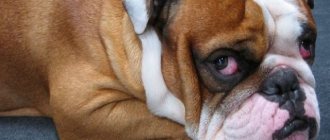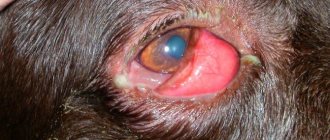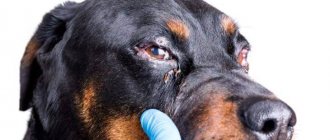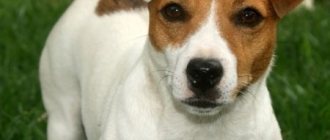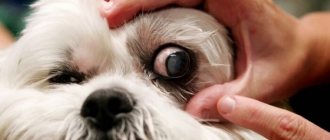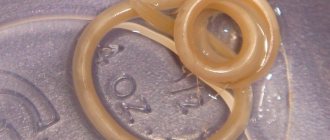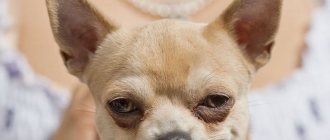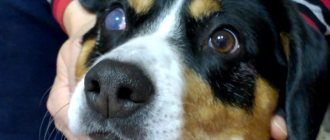Physiological reasons
This group includes everything that is not related to internal processes. In this case, the disorder occurs due to external factors affecting the visual organ.
Entry of a foreign object
One of the most common reasons why a dog squints its eyes is due to a foreign object. During a walk, a small blade of grass, a piece of leaf, a cobweb or dust may stick to the mucous membrane. Most often, curious puppies suffer from this problem, sticking their little faces everywhere.
Injury to the cornea or eyelid
Mechanical damage to the cornea and eyelid occurs due to injuries and bruises received during active games or fights. The pet may run into a sharp stick, run straight into a wall, or compete with another dog. The risk group includes breeds with bulging eyes.
Burns
Chemical and thermal burns are most common in dogs. The first group includes cases of damage from aggressive household chemicals, and the second - from direct sunlight.
Photophobia
An inadequate reaction to light is not an independent pathology, but is a symptom of it. Avoidance of direct sunlight is characteristic of many infectious and ophthalmological diseases. Only an examination by a veterinarian will help you understand the real cause of the illness.
Symptoms of major diseases
Symptoms of eye disease are largely related to the age group, general health, body stability, frequency of negative influences, cause and stage of infection. Symptoms may include:
- discharge of pus, lacrimation;
- accumulation of fluid in the corners of the organs of vision (exudate);
- formation of scabs and scabs on the skin of the eyelid;
- swelling and redness of the eyelid;
- itching and burning;
- increased blinking frequency;
- scleritis, leukoma, opacity of the corneal layer;
- increased body temperature, weakened and lethargic state of the animal;
- impaired pupillary reactions in light, photophobia;
- blepharospasm;
- decreased vision.
Pus discharge from a dog's eye indicates a disease
What you need to know! Be sure to take your pet to the veterinarian if you notice these symptoms. After diagnosis and examination, the specialist will make a diagnosis and prescribe the necessary medications.
Pathological causes
This group includes congenital and acquired pathologies. The resulting disturbance may act as an indirect symptom or indicate a real problem with the visual organ.
Eye diseases
The main danger of ophthalmological diseases is partial or complete loss of vision. To save your pet, it is necessary to find out the cause of his illness as soon as possible and begin treatment.
The most common eye pathologies in dogs include:
- Conjunctivitis
, or inflammation of the mucous membrane. Damage to the conjunctiva is caused by bacteria, viruses, fungi, allergens and foreign bodies.
- Uveitis
, or inflammation of the uveal tract. The causes of uveitis are similar to conjunctivitis. The only difference is that it is not the mucous membrane that becomes inflamed, but the choroid.
- Keratoconjunctivitis sicca
, or dry eye syndrome. Occurs due to chronic conjunctivitis or disorders within the lacrimal gland. In the latter case, the problem is explained by a breed predisposition or an incorrectly performed operation for adenoma of the third eyelid.
- Enophthalmos and exophthalmos
. Retraction and prolapse of the eyeball occurs with severe bruises, increased internal pressure and weakened muscle tone.
- Glaucoma
. It develops as a result of congenital anomalies, mechanical damage, lens displacement and as a complication of uveitis.
Despite the fact that a sick animal squints in all of the listed diseases, each case has a different treatment regimen. Because of this, veterinarians recommend not starting self-administration of medications until a diagnosis is made.
Diseases of the eyelids
Squinting is also characteristic of pathologies that cause deformation and inflammation of the eyelid. These include:
- ectropion (inversion) and entropion (inversion), differing in the direction of bending;
- distichiasis and ingrown eyelashes, often developing as a complication of entropion;
- blepharitis, that is, inflammation of the edges of the eyelid on one or both sides.
Most often, the listed pathologies arise due to infection or due to breed predisposition. Depending on this, they are treated with antibiotics or eliminated through surgery.
Infectious diseases
The risk group includes unvaccinated pets. Photophobia develops in the following diseases:
- plague of carnivores (distemper);
- parvovirus enteritis;
- rabies;
- leptospirosis.
The last two infections are dangerous not only for animals, but also for humans. If you suspect rabies or leptospirosis, be sure to isolate your dog until the veterinarian arrives and do not come into contact with it until a diagnosis is made.
Allergy
Allergic reactions are caused by chemicals, pollen, tobacco smoke, certain foods, and even ordinary dust. Irritation of the mucous membrane is one of the most common signs of allergies, often accompanied by redness of the eyelid, tearing and runny nose.
Reasons why your dog itches a lot
- First of all, these are parasitic insects visible to the eye: lice, fleas, lice eaters. You can independently examine the animal in search of these parasites; just part the fur. If black specks are found on the skin, then these are fleas.
- If transparent bubbles are visible on the hairs of the fur, we are talking about lice.
- The lice eater can be noticed by the results of its sabotage - on the dog’s body you can see places where the hair looks as if it has been trimmed evenly. Here the dog scratches incessantly.
- Severe itching is also caused by mites invisible to the eye, which cause a variety of diseases: linguatulosis (the mite settles in the dog’s nose), otodectosis (the mite is localized in the ears).
In pruritic scabies (sarcaptosis), a microscopic mite deeply damages the skin and causes persistent, severe itching. The dog is actively itching at night. This condition leads the animal to nervous and physical exhaustion; it cannot eat and can even die.
Cheyletiosis is caused by a mite that lives on the surface of the skin. On dark fur they are noticeable like moving dandruff. That is, if in addition to itching, your dog has dandruff, you should take a closer look at it to see if it is a mite. If your dog is not only itching, but also losing hair, you may suspect a food allergy.
It is worth remembering whether anything has changed in the animal’s diet recently. This applies to both natural food and dry food. With similar symptoms, such a dangerous disease as demodicosis or red scabies occurs. With it, itching is often accompanied by purulent inflammation of the skin.
Lesions of the skin and fur begin on the outside of the forelimbs. They are red in appearance and the fur is falling out. To determine the pathogen, it is necessary to urgently scrape the skin.
Associated symptoms
Depending on the cause, squinting may be associated with other worrying symptoms. These include:
- apathy or aggression;
- poor appetite and sleep disturbances;
- redness and inflammation of the conjunctiva;
- excessive tearing or the appearance of purulent discharge;
- clouding of the iris, strabismus and prolapse of the third eyelid;
- increase or decrease in temperature;
- enlargement of the pupil and the appearance of a greenish cataract;
- gluing of eyelashes and formation of erosions on the cornea;
- repeated vomiting and bloody diarrhea with the smell of rot;
- yellowing or blanching of the mucous membranes.
Because there is a wide range of possible causes, do not rush to make a diagnosis before contacting your veterinarian. Even an ordinary blade of grass can lead to quite serious consequences if an infection gets into the scratched wound. Limit your actions to first aid and be sure to take your pet for examination.
What causes a dog to itch and lose hair?
A common disease is lichen. It has a different nature and many forms, but it manifests itself in the same way:
- the pet is itching;
- a rash appears on the skin;
- these areas become bald over time;
- they form conglomerates and spread rapidly.
We suggest you read: Why does a Chihuahua scratch its ears?
There is weeping lichen, then moist crusts with discharge appear on the skin. It is difficult to notice the disease in breeds with folds. They need to be examined regularly and monitored skin hygiene.
How to help your pet
If you notice alarming symptoms, act according to the circumstances. In some situations, the problem that has arisen can be eliminated on your own, but in most cases you will have to go to a veterinarian - or call him to your home.
When do you need a veterinarian diagnosis?
Diagnostics at a veterinary clinic will be required if there is a suspicion of an infection contagious to humans (rabies, leptospirosis) and if there are symptoms dangerous to the health of the animal. Be sure to seek help if your pet:
- He closes his eyelids tightly and whines pitifully when he tries to open them. Severe pain is typical for injuries and sharp objects stuck inside the eye socket.
- Hides in dark corners, avoiding any light sources. Photophobia is characteristic not only of inflammatory diseases, but also of rabies.
- Fever, suffers from repeated vomiting or diarrhea. Dehydration is very dangerous and can be fatal, especially in fragile puppies.
- He cannot open his eyelids because of the pus that has dried on them. The appearance of purulent exudate is a very alarming sign that accompanies the inflammatory process.
- Suffered an injury or chemical burn. Apply a sterile bandage to the damaged area and limit access to it using a protective collar.
- Suffered from prolapse or retraction of the eyeball. Both diseases can only be eliminated surgically. A similar situation is typical for inversion and eversion of the eyelid.
- He lost his pupil's reaction to light, and a greenish cataract appeared on his iris. Glaucoma cannot be cured, but its progression can be slowed down with medication.
The type of therapy will depend on the diagnosis. In most cases, medication and proper care will be enough for recovery.
When can you solve a problem yourself?
First, carefully examine the eye that is bothering your dog. If a blade of grass or other harmless object is stuck in it, carefully rinse the mucous membrane with running or warm boiled water. It is also permissible to use a cotton pad soaked in saline solution. You cannot use only cotton wool, as its fibers will aggravate the existing irritation.
To relieve pain from a thermal burn, use a cold compress, and to relieve itching and reduce inflammation, use tetracycline ointment or chloramphenicol. Perform all manipulations with clean hands to avoid introducing infection into the existing wound.
In case of an allergic reaction, the animal can be given an antihistamine. The drug Suprastin is suitable from the human first aid kit. The important thing to remember here is that allergies often return, so don't wait to see your veterinarian after your symptoms have subsided.
Veterinarian's medication prescriptions
Antibiotics and antivirals are used to treat infections. All other drugs are prescribed to relieve symptoms and may include:
- anti-inflammatory;
- antihistamines;
- cholinomimetics that improve the outflow of intraocular fluid (for glaucoma);
- painkillers;
- acaricidal;
- artificial tear substitutes;
- immunomodulators;
- glucocorticosteroids.
If the dog squints one eye, then the prescribed drops will still have to be instilled in both. Regular care, including soaking dried crusts, will help avoid injury to neighboring areas.
Surgical intervention will have to be resorted to when:
- deeply embedded foreign bodies that are not amenable to tweezers;
- follicular conjunctivitis;
- enophthalmos and exophthalmos;
- improper eyelash growth;
- ectropion and entropion.
During the rehabilitation period, it is necessary to monitor the condition of the operated area, avoiding inflammation and suppuration. Treat the wound with special ointments only if your doctor advises it. Moisturizing slows down tissue regeneration, so it is best to avoid it.
Features of treatment for puppies
Due to their age and weak immunity, puppies are more susceptible to illness and many medications. It is recommended to immediately show small pets to a veterinarian, as most standard medications are not suitable for them. The dosage also requires adjustments, so you should not self-medicate on the advice of friends.
Types of visual pathologies in dogs
Blepharospasm
Involuntary contraction of the orbicularis oculi muscle (blepharospasm) - repeated contraction of the muscles of the eyelid. The dog begins to avoid light, and the eyes secrete exudate. The eyelid swells and becomes painful.
Keratitis
Keratitis is an infection and inflammation of the cornea due to damage. Keratitis is often caused by infectious pathogens such as bacteria, adenoviruses, fungi, and thelaziosis (helminths). The dog begins to squint his eyes, scratch his eyes with his paws, become nervous and behave restlessly.
Keratitis is very dangerous and can lead to serious complications if not treated correctly.
Prolapse
Prolapse is a deviation in the placement of the lacrimal gland of the third eyelid. After the loss, inflammation and swelling occur. A characteristic feature of this deviation is that it can appear and go away after some time.
It is believed that prolapse has a hereditary predisposition
Conjunctivitis
Conjunctivitis is an inflammatory process of the film membrane (conjunctiva). The animal blinks frequently, constantly touches its eyes with its paws, and whines. In most cases, it has a viral and bacterial form.
